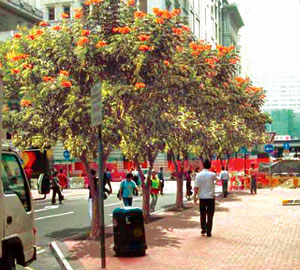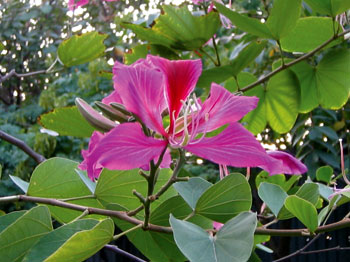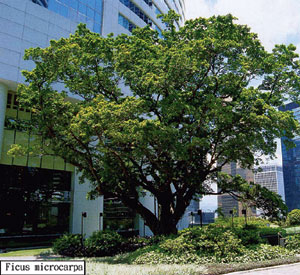Periscope
Related Stories

The government has planned to plant more trees in Tsim Sha Tsui. Courtesy of CEDD
Greening districts with unique themes
By Rachel Yip
A “concrete forest” with no green plants, the image of the Hong Kong environment, will have some changes very soon through the greening project launched by the government.
The Steering Committee on Greening, set up by the Works Branch of the Environment, Transport and Works Bureau, aims at setting the direction and the focus of the overall greening strategy stated in the Policy Address, and at supervising the implementation of major greening programs. The Public Works Committee on Greening, which is under the Steering Committee, is responsible for drawing up the greening master plan for the project.
Mr. T. K. Tsao, Head of the Public Works Committee, who is also the Head of the Civil Engineering and Development Department (CEDD), said, “Those old districts like Central, Tsim Sha Tsui, Wan Chai and Kwun Tong will have the priority to be greened first.
“We not only want to green the places, but also intend to create a representative theme for each area.”
The first place to be greened is Tsim Sha Tsui, with the theme called “Jade Necklace”. The idea is inspired by the existing green spots there – Kowloon Park, Signal Hill Garden, Salisbury Garden and Centenary Garden. The committee is planning to link them together by a corridor of trees to form a green “necklace”.
The aim to create themes on greening is to vivify the identity of the places and to make them more memorable. “Setting up themes in different locations can enhance the overall visual quality of the environment,” said Mr. Tsao. “These themes are proposed by various experts and consultants. I think they are very creative and intelligent.”
The master plan was finalized at the end of March 2005. After consultation, the committee will start the construction works in the middle of 2005. This short-term plan is scheduled to be completed by the end of 2006. This plan will try to maximize the available planting opportunities in urban city areas.
Actually, the project is not as easy as it seems. The most serious problem is the limited space for growing plants in the highly urbanized areas.
Mr. Tsao explained, “Greening was not included in the town planning years ago. So there is not much space left and the planting areas are very limited. Unlike the development of new towns such as Tseung Kwan O, where there is plenty of space for tree planting, greening the existing streets in well-developed areas is very difficult.”
Moreover, the soil mass underneath those developed places is not large enough for planting large trees. Mr. Tsao said, “Beneath the pavements, there are layers of highly congested utilities such as cables, electric wires, gas pipes and sewage pipes.
“Our preference is to plant large canopy trees, which are considered to bring significant and sustainable greening effects to the place. But the tree roots have to be three times larger than the canopy in order to support the trunk and the canopy. Soil mass in these areas is not large enough for us to grow such large trees. That's why along the roadside we can only see trees that are often with small or even no canopies.”
To tackle this problem, some greening methods, such as planting trees and shrubs in containers, or hanging baskets onto handrails and lamp poles, will be considered. There will also be rooftop planting on elevated walkways and planting along expressways. Climbers will be planted to green the pillars under some footbridges.
Besides the technical problems, the committee has to face the opposition from some parties. “Although as our consultation revealed, the public is generally in support of the greening project, sometimes the work may disturb others. For example, the planting will obstruct the view of advertisement boards of the nearby shops. Thus we have to discuss with the concerned parties,” Mr. Tsao said. They will conduct appropriate public consultation on both the Greening Master Plan and the detailed greening proposals prior to their implementation.
The second greening target of the master plan is Central. As Central is a financial center of Hong Kong , the plants chosen will be mainly golden and yellow in color so as to meet the theme. So, some exotic plants of these colors have to be imported.
Kathy Ng, a senior landscape architect, said, “The public has the wrong concept of ‘exotic' breeds. The breeds we will adopt are the plants grown within Guangdong Province only, but not from other countries. Actually, it's hard to find types of plants that only grow in Hong Kong .”
However, some environmentalists are concerned that importing other breeds will damage the ecology of Hong Kong .
Prof. David Dudgeon, Dean of Department of Ecology and Biodiversity, The University of Hong Kong, expressed his opinion about the plant species that the project has adopted. “I am not sure whether we could classify species from Guangdong as exotic, because Hong Kong and Guangdong are of the same biogeographic region. On the face of it, it is rather unlikely to have native species of Guangdong that do not occur naturally in Hong Kong .”
“But I think native species are generally better. And whatever exotic plants are used, they should not have the capacity to naturalize, that is, they should choose species that are not able to breed under HK's climatic conditions. Those exotic species will not damage our ecology.”
It is advantageous to use the exotic breeds. Miss Ng explained, “We use them because only those species can bear the tough growing environment in the urban areas. We also hope to use local seedlings, but it is too difficult for them to grow.
“Imagine standing on Queen's Road Central for the whole day. There is light and heat reflected by the windows of buildings along the road but no fresh air. It is difficult for humans to do so. It is the same for trees. There is also no clean water and nutrients from the soil, and no irrigation except natural rain,” said Miss Ng, “For trees, streets in Hong Kong are just like a desert.”
Bauhinia is one of the examples of local species. Although Bauhinia is the flower of Hong Kong , it is seldom seen on the roadside, mainly because it cannot grow well in a hostile environment. Only in some open space such as parks and countryside can Bauhinia grow better.
In contrast, the trees planted along Nathan Road , one of the busiest streets in the city, are Ficus microcarpa, which is not a local plant. “To me, Ficus microcarpa is the best tree to be grown in Hong Kong ,” Mr. Tsao said, “It has a large canopy and is adaptable to the hostile environment. Once planted, it can grow well no matter how adverse the surrounding is.”
Another reason for adopting exotic species is that they can grow faster. “They are planted as pioneer species. They are good for erosion control because they can quickly hold the soil. Thus, the soil can start to gain stability and to store more nutrients. When the soil becomes fertile enough, the local species can be planted there.
“Introducing pioneer species for greening has been used for many years. It is well proven to be successful. We have also sought professional advice from experts in order to maintain a balance between adopting native and exotic species, so no harm will be caused to Hong Kong 's ecology.”
“Greening Hong Kong is a very good investment,” Miss Ng said, “Planting a group of trees only requires a thousand or more dollars. The capital is small but the reward is large and beneficial. The whole cityscape will be Hong Kong 's heritage.”

Bauhinia, the flower of Hong Kong Courtesy of CEDD

Courtesy of CEDD